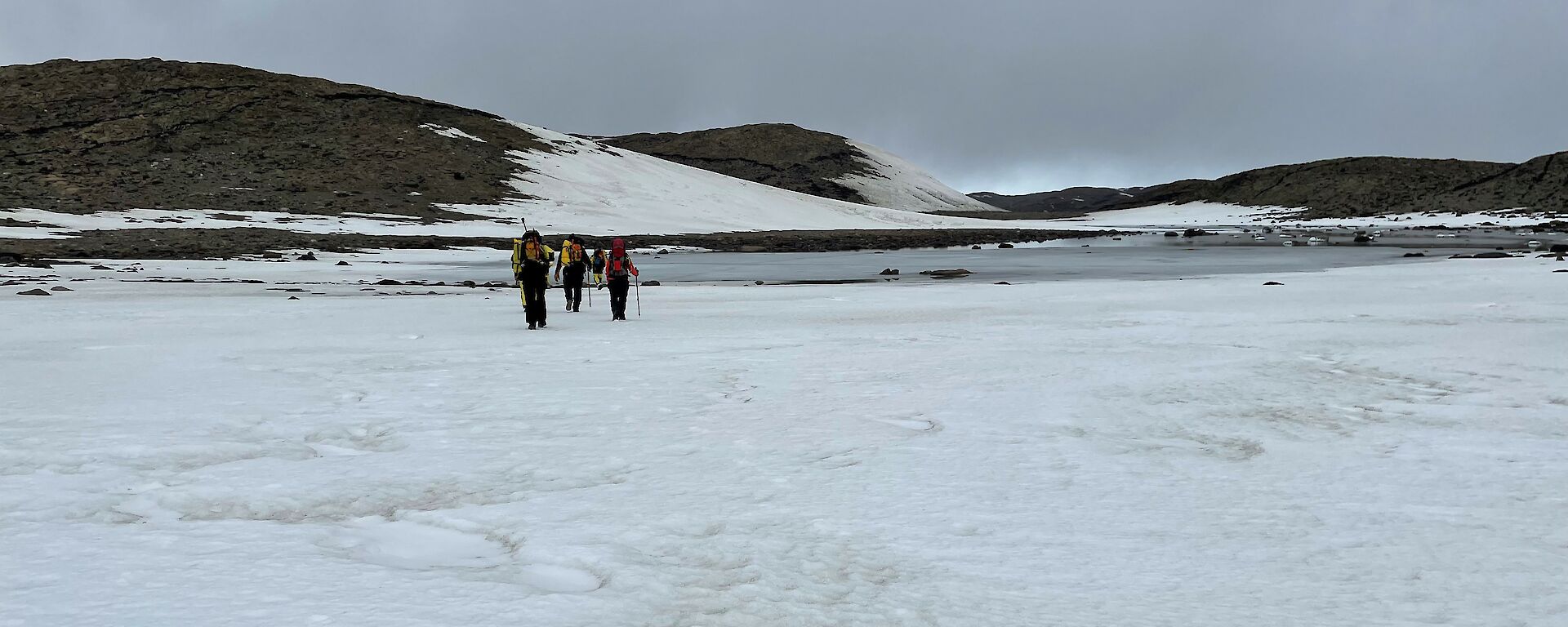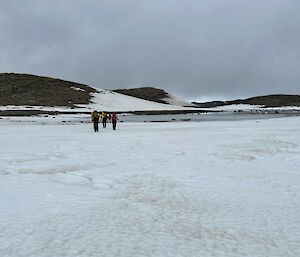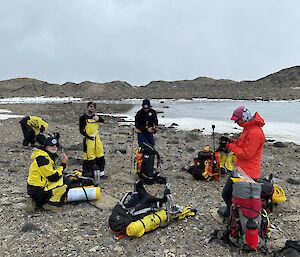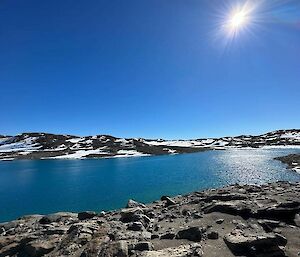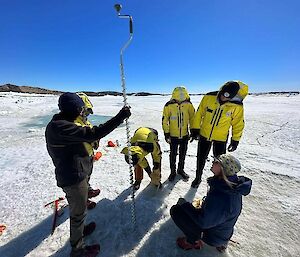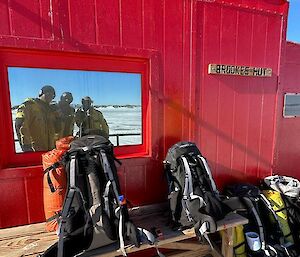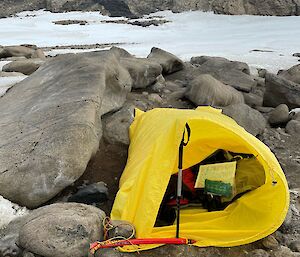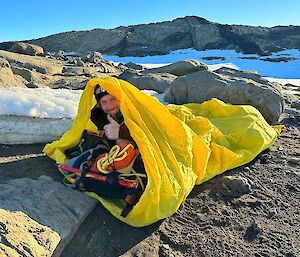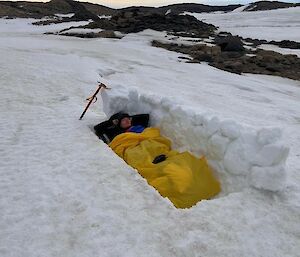One of the first things a new expeditioner is required to do after arriving in Antarctica is survival training. This ensures that should an expeditioner become lost or injured in the field, they have the skills to survive overnight or longer in the cold Antarctic environment while they await rescue.
Survival training involves sleeping outside overnight, just a little bit colder than camping in Australia. The first step in survival training requires the nervous recruits to meet the Field Training Officer (FTO) at the field store where they are fitted for a field pack and issued the various bits of kit that need to be carried in the pack at all times.
These items include a heavy down sleeping bag, a foam roll mat, a “chip packet” (windproof bivvy bag), a wee bottle, a “wag bag” (for number twos) and a sealed bag for storing used wag bags, a throw rope for sea-ice rescue, ice-axe, maps, compass, whistle, and a one litre water bottle. Expeditioners must also carry in their packs, or wear, the full survival outfit which includes woollen socks, thermals, thick mittens, beanie, balaclava, buff, goggles, micro-spikes, power-stretch polar-fleece layer (pants and top), 300gsm polar fleece layer, and windproof gortex overalls and a jacket. There are also lots of other safety items the expeditioner needs to carry with them if they venture out into the field (e.g. radio, PLB and GPS) and many of these were covered in the article on SAR training in last week’s Station Update.
By the time you add a walking pole, food and extra water, the field pack can weigh upwards of 16kg, a huge weight to carry through the rocky Vestfold Hills. You certainly know you’ve been for a walk after a day of hiking!
In case you were wondering, you can’t just go to the toilet anywhere you like in Antarctica. You need to “take it out with you” and dispose of anything in a proper disposal facility on station. You can only empty your wee bottle in the ocean or in a tide-crack. Everything else, including toilet paper comes back to station.
Chip packets are so known because of their rectangular shape and crinkly properties. They are essentially a nylon bag with a draw-string at the top. If you get caught out, this is what you sleep in.
After being inducted in all the components of the pack, the FTO takes the expeditioners into the field and teaches them the art of map-reading, using a GPS and compass, and navigating using landmarks. Everyone gets a turn to choose the best route to the overnight destination. For most of us this season, that destination was Brooke’s Hut, a leisurely 10km hike through the rocky Vestfolds. There are no paths, just lots of rocks and boulders so you really have to watch your step. Thankfully, someone was feeling kind and we were dropped off on Dingle Road so really only had to walk about 6km on day 1.
Out the front of Brooke’s Hut is Shirokaya Bay which at the time of survival training had a good thick cover of ice (190cm). We knew this for a fact as we were taught the art of sea-ice drilling for depth measurements, something that will be very important to us in the season ahead. Our agenda for sea-ice training included; use of a throw bag and ice axe, sea-ice drilling and depths, walking and travelling on sea-ice (must be in pairs at least), communications on sea-ice, and tide-crack awareness. We all practiced throwing a rope to simulate what we would do if someone fell through the ice.
Wildlife is a feature of Antarctica that never ceases to amaze expeditioners, and dotted around Shirokaya Bay were several Weddell seals basking on the sea-ice. Part of training includes awareness of wildlife – it is important to maintain minimum distances (varies by species) so we don’t scare animals or disrupt their natural behaviours. We are also briefed on environmentally sensitive areas surrounding Davis so we don’t inadvertently enter them during field travel.
Once suitably cold after the sea-ice drilling, we were inducted in the use of the fuel stoves and our mission was to heat ourselves a dehydrated meal. No cooking skills were required as the only thing needed is the ability to boil water and heat the meal in its pouch.
Maintaining good communications while in the field is an essential aspect of Antarctic travel so after dinner, we did a detailed “sched” or “sitrep” with VLZ Davis (home-base). The sitrep follows a sequence and provides information about location, health, vehicles, intentions, weather, track conditions, and any other relevant information.
We were also taught the skills necessary to safely use a field hut including how turn on the gas and heating, open vents, and use the CO monitors. There is an order you must do things when arriving at a field hut and again when leaving. This ensures everyone stays warm and safe.
Sadly, the new recruits weren’t afforded the luxury of Brooke’s Hut – this was reserved for the very experienced FTO who didn’t need to learn how to sleep in a chip packet. Instead, we needed to find ourselves a suitable campsite, roll out our chip packets and set ourselves up inside with the foam roll mat and down sleeping bag.
You can be as creative as you like in terms of the inside set-up and many people used their packs, walking poles and ice-axes to create a structure for their chip packets. Some brave souls chose to set-up their chip packets in the snow, others opted for the firm and stony ground behind Brooke’s Hut.
Our very kind FTO boiled some water in the hut for us to pour into our 1 litre water bottles. This served two purposes; to use as a hot water bottle, and to ensure the water didn’t freeze overnight in the event you needed a drink! This is not something you generally contend with in Australia. In fact, many things need to go in the sleeping bag with you to ensure they stay warm enough for use the next day. This includes your phone, batteries, food you want for breakfast, and drinks. It makes for an interesting night’s sleep with your pockets stuffed full of these items. Still, much better to sleep with your breakfast muesli bar in your pocket than attempt to eat it frozen the next morning.
Thankfully, we all more than survived and our kind-hearted FTO even checked on us twice during the night to make sure we were OK. Everyone agreed that it was particularly interesting camping out under a blazing sun that doesn’t set. After a quick breakfast, it was time to pack-up and head back to station. Despite being a little weary from lack of sleep and carrying heavy packs, we all learnt some really important lessons about how to safely work and travel in the Antarctic environment. Many thanks to our excellent field training officers Paula and Kat!
Karen
Davis SL

